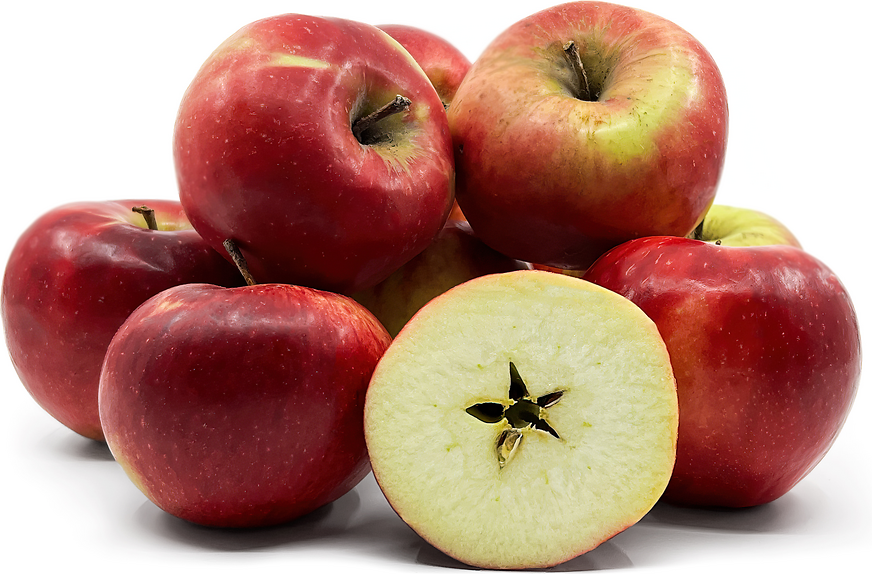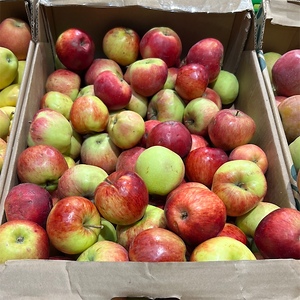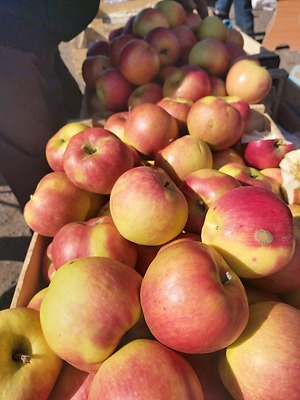


Rashida Apples
Estimated Inventory, lb : 0
Description/Taste
Rashida apples are large, spherical fruits with a conical, slightly flattened, to ovate shape. The skin is smooth, waxy, firm, and has a yellow-green base, covered in bright red blush and striping. There may also be prominent white lenticels scattered across the surface. Underneath the skin, the flesh is crisp, white to pale yellow, aqueous, and fine-grained, encasing a central core with small, black-brown seeds. Rashida apples are aromatic and have a balanced, sweet-tart flavor with mild acidity and notes of spice.
Seasons/Availability
Rashida apples are harvested in the late summer and can be stored through the winter.
Current Facts
Rashida apples, botanically classified as Malus domestica, are a rare variety that belongs to the Rosaceae family. The sweet and tangy apples are a natural cross between jonathan and aport apples and were bred to exhibit the most favorable qualities of each parent variety. Rashida apples are chosen by local orchards in Central Asia for their resistance to disease, drought tolerance, and productive nature. While the variety is not commercially cultivated on a large scale, the apples are considered specialty cultivar that can be utilized in both raw and cooked culinary applications.
Nutritional Value
Rashida apples are a good source of fiber, which can help regulate digestion and contain vitamins A and C, which are antioxidants that can boost the immune system. The apples also provide some vitamin E and vitamin K.
Applications
Rashida apples are best suited for both raw and cooked applications such as roasting, baking, and stewing. The apples are commonly consumed straight, out-of-hand, as their sweet and tangy flavor is showcased when eaten fresh. Rashida apples can also be sliced into wedges and served with cheeses and spreads, chopped and tossed into salads, or diced into cereals. In addition to fresh applications, the fruits can be baked into pies, crumbles, strudel, and cookies, shredded and fried into fritters, cooked into pancakes, or served with roasted meats. In Kyrgyzstan, Rashida apples are minced into dumplings, chopped and stirred into rice, baked into apple charlotte cakes, or dried for extended use. The apples are also commonly pressed into juice known as kompot and are mixed with other fruits to create a refreshing drink. Rashida apples pair well with meats such as poultry, pork, beef, veal, and horse, which is a specialty of Central Asia, dried fruits such as raisins and dates, garlic, rice, carrots, cucumber, cinnamon, nutmeg, honey, and vanilla. The fresh apples will keep 2-3 months when stored in a cool, dry, and dark place.
Ethnic/Cultural Info
In Kyrgyzstan, the Gareev Botanical Garden was created in 1938 and was named after Professor Gareev, scientist and breeder of the Rashida apple. The gardens are a part of the National Academy of Sciences of the Kyrgyz Republic and are a center for education, research, and conservation to develop new fruit and flower varieties for Central Asia. There are over five thousand different species of plants found at the botanical garden, and in addition to research, scientists working for the garden also frequently partner with international conservation groups to study, preserve, and improve the varieties of fruits trees locally found in Kyrgyzstan.
Geography/History
Rashida apples were developed by Professor Gareev at the Botanical Garden at the National Academy of Sciences of the Kyrgyz Republic. While the exact date of when the variety was created is unknown, the cultivar was bred within the last century and is primarily grown in the Issyk-Kul region of Kyrgyzstan. Issyk-Kul is known for its fruit orchards and provides a unique climate where apples can be grown without the need for chemicals. Today Rashida apples can be found at local markets throughout Central Asia. The Rashida apples in the photograph above were found at a weekend food fair in the Zhetygen village in the Almaty province of Kazakhstan.









